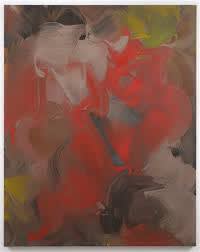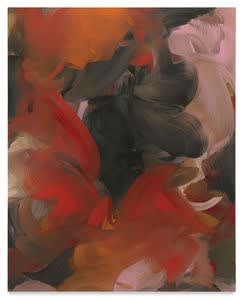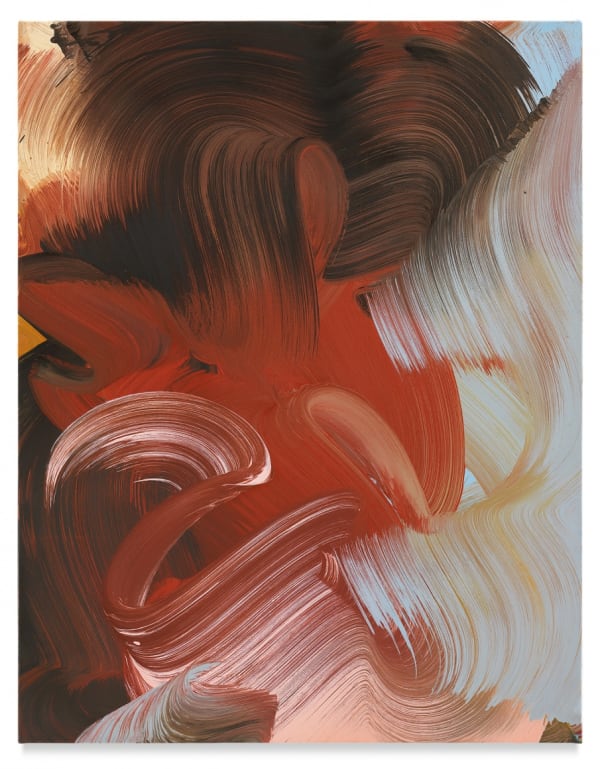ERIN LAWLOR
@THEERINLAWLOR
It is always incredible to me the astounding opportunities offered to me by this page and this amazing community. One such opportunity was the chance to speak to one of my all time favourite female artists, Erin Lawlor, about her studio, her work, her inspirations, her life and her dream dinner parties!
Lawlor’s work is as instantly recognisable as it is evocative, incurring feelings of a sublime and sensitive decadence.
“Paint, Time, Fold”
Raised in Essex, Lawlor’s studio is in the Old Percy Dalton Peanut Factory in East London, gritty and high-ceilinged with rays of light pouring through the north facing windows.
“The use of colour is inevitably highly intuitive - but then again it is also grounded in thirty years of practice and experience that it is hard to quantify. I’ve certainly become more confident in my use of colour in recent years, the stronger cadmiums in particular.”
-
INTERVIEW
First of all Erin, what is your instagram handle:
@theerinlawlor
Where are you answering these questions from?
Home, which these days is East London.
i love this question - Erin, how would you describe your work in three words?
Paint, time, fold.
Tell me about your artist career so far? How did you get to where you are now?
Essentially I’d say stubbornness! I was working very much in a vacuum for a long time – not having been through art school, and working as I was in France, which was strongly anti-painting really throughout the eighties and nineties. And juggling constantly, between parenting and paid work and trying to keep studio time. In many ways though I look back on this period as a formidable incubator, a time to both learn my medium and find my own voice. It seems hard to remember now, but in those years there wasn’t at all the same sense of necessarily managing to have a market career, and if there was it was a long-haul thing, not a recent-graduate thing. And pre-social media there was the difficulty of getting the work out there, but on the up side there was also the time to fall down and get up again (and fall down again!) without the world watching! I’d been painting for about fifteen years before I started exhibiting.
Social media completely changed the opportunities for visibility, and there was almost immediately much more interest in my work from other countries, particularly the US and Germany, where there seemed to be a more immediate understanding of what I was trying to do with paint, through their traditions respectively of AbEx and of Radical Painting. I took to curating in my last years in Paris, to counter my frustrations at the lack of painting I was seeing there.
I moved back to London in 2013, and I have found there is much more of a community here, even if the market still seems to be more geared towards figurative painting.
HAS IT BEEN A QUICK JOURNEY?
Generally speaking, it’s been a slow build over the years, very much through word of mouth, other painters suggesting my work to galleries, and then gallery shows leading to other shows… A few high points, in terms of institutions, have been my work being shown at the Ny Carlsberg Glyptotek Museum in Copenhagen in 2016, by curator Line Clausen Pedersen, and a more extensive solo survey at the Rothko Centre in Latvia in 2017. As to my current representation, I have been working with Fox/Jensen and Fox/Jensen/McCrory Galleries in Australia/NZ since 2017, and Miles McEnery NY for about two years now.
-
Where did you grow up ERIN, AND What did you study?
I grew up I Essex, not far from Epping - so the countryside, but at the end of the Central line, and a stone’s throw from London. I left the UK straight out of school for a year off – and ended up living in Paris for the next twenty-six years…I studied there, at the Sorbonne University; a degree in History of Art and Archaeology, a side-step from English Lit which had been my intention prior to that; and one that clearly bought me squarely back to painting as a medium of expression – logically enough in that by then I was obviously living in between two languages otherwise. Paint had the advantage of being both more universality and less explicit.
INCREDIBLE. Your use of media is so interesting. Tell me about your artistic process, and how each work comes to be?
When I came back to painting, it was very clearly through a love of oil paint, through late Titian and Rembrandt; Manet, Soutine, and Auerbach…that was in many ways the objective of my first ten years of figurative work – simply learning and pushing the medium.
For a long time now I’ve been working on the ground, with large brushes and with very liquid oil paint, alla prima. The first few layers have to be dry enough to provide a stable base, before the work proper. Those first layers are important in that the base colours will affect those that come after, but I admit they also allow an easing into the work for me, a necessary desacralization, a doing away with the blank canvas. How the actual painting comes about is very much an organic process, a dialogue in the moment – while I may set out with a colour or a mood or a theme, I find too much intention kills a painting.
I am obsessed with your use of colour Erin. Tell me a bit about your palette. Do you plan? Is it intuitive?
Colour is such an extraordinary thing – it has the propensity of being so directly expressive and evocative, I think there is a level of synaesthesia that operates in almost everyone…There are obviously specific colours that appeal and are very evocative on their own account; yet working wet on wet, so much is about the interaction, both the juxtaposition, but also the intermingling of layers…And it’s a way of working means that it is impossible to plan specifically – nor would I want to – so much of the excitement of painting is down to being open to, and even at times surprised by, what is happening on the canvas and reacting to it – a series of micro-decisions that are barely conscious…So the use of colour is inevitably highly intuitive - but then again it is also grounded in thirty years of practice and experience that it is hard to quantify. I’ve certainly become more confident in my use of colour in recent years, the stronger cadmiums in particular.
If you had to describe yourself as a colour, which colour would you be, and why?
Blue. Ocean, sky; and just because – it’s a purely instinctive but obvious response!
-
-
AS WELL AS THIS USE OF COLOUR, What would you say is the most significant aspect of your art? And how did this come about?
The brush-mark always has been – even in my early very figurative work. And in the work of those painters who fascinated me then, and still do. The way in which a brush-mark can capture and express colour, form, even time…can be vastly evocative and endlessly open. It took me a long while to trust and go with that, to let go of the need to hang the brush-mark onto an overt subject. Much of the evolution of my work has been to do with that desire to keep the aliveness of the mark-making: over the years the brushes got bigger, the paint more liquid, and then implied the shift to working horizontally, on the ground. The main evolution in recent years has been the complexity of composition, as the works themselves expanded, combined with a greater confidence in the chromatic range.
Tell me about your earliest memory surrounding art, and when did you decide to pursue a career in art?
I can’t remember a time when art wasn’t part of the environment, both at home – the William Morris wallpaper in my bedroom in particular had an insidious presence – or outside, an awareness of exhibition posters on the walls of the Underground for example. One seminal experience for me was the immersion in Ravel’s Garden room at the ‘Hockney Paints the Stage’ exhibition at the RA when I was in my early teens - the walls were all painted in an extraordinary electric blue, with vivid red trees stretching into the horizon…that room was a pure and almost blinding revelation of the possible effect of colour and spatial distortion – the creation of a reality other, on its own terms, just as valid.
The creative impulse was always there, from childhood, through writing or drawing and painting – everyone drew well in the family – but there wasn’t really the thought that it could be a career per se. I was in my early twenties when I realised I wanted to make painting my life’s business, but I was very aware that at the time it wasn’t necessarily something that would provide a sustained living. I rather assumed I would have to do other things to pay the bills. I still struggle with saying I’m an artist. I’m a painter, rather, anyway; that’s my medium.
-
"There is always a to-and-fro between the studio and the rest of life; things, visual and emotional, that seep in to the studio; but also the activity in the studio as a pre-emptive response, a form of logotherapy, a meaning, a stepping away in order to both expel but also re-arm."
What is your studio like Erin? What are your artist essentials, and what do you listen to while you work?
My studio these days is in the Old Percy Dalton peanut factory in East London, a ground-floor space, gritty and high ceilinged, through Space Studios. Light is essential – its north-facing, though the windows can almost be a distraction when the light plays on the late afternoon.
ANY OTHER ESSENTIALS?
My other essential is drop-sheets; I work on the ground and it would be a skating-rink without their absorbency. And it’s a necessary liberation not to worry about mess!
What does an average working day look like for you?
There’s not really an average day – it’s more a question of cycles - of re-stretching canvases (I edit a lot); and prepping backgrounds, and paint-mixing, and the work proper…and then the cleaning of tubs and brushes, and looking and culling, not to mention all the logistical side of things – shipping, accounts…I’m not good at delegating. I try to have everything well prepared when I’m settling in for a real paint binge, particularly on the larger formats - it’s very immersive and it is important to me that it be so, that I have no outside time limits…Working in the wet means a relatively short window to pull the whole together, so it’s something of a tight-rope. It’s immensely gratifying and exciting when things do come together.
Who or what are your greatest influences, and how do these come out in your work?
Some are constants – late Titian, Soutine…others surprise me by creeping into the studio almost unbidden – a trip to Rome two years ago led to Caravaggio sneaking in, which was a surprise to me…and then all those baroque ceilings! Classical painting generally. And then I do love Howard Hodgkin; also De Kooning and Guston, obviously - what I get from all their work is that aliveness of the paint, of the mark.
But then like most painters probably, I’m a bit of a visual magpie, and all sorts of things find their way into the work – there are cartoon references and children’s illustrations – both Sendak and Dr. Seuss…also music, a wide variety.
Have you been influenced or inspired by something in particular recently?
After Matthew Wong died last year I found myself for some weeks working with an intense electric blue that I very much associate with him.
Lockdown has been an inevitable turning-inwards, visual memory, with it’s inevitable filters, is a big part of the work anyway. I rushed out to see the Titian exhibition at the National Gallery on the first day it re-opened. Still, and always, incredibly nourishing.
I WAS GOING TO ASK YOU ABOUT LOCKDOWN. AMAZING THAT YOU SAW THE EXHIBITION. SO, What questions drive your practice? What are the focuses and themes of your work?
I’m not sure if there are questions as such these days -
The focus is always oil paint, its viscosity and aliveness, and colour. I have periods of using certain colours, the range of pinks from a quinacridone pink, or how cadmium red light reacts against different blues.
The themes change. I spent much of the winter working on a series of ‘seasons’ paintings, which grew out of a need for perspective - my son was very ill, just prior to lockdown, we were waiting for an operation; there was a sort of need to feel ‘this too shall pass’.
‘this too shall pass’.
There is always a to-and-fro between the studio and the rest of life; things, visual and emotional, that seep in to the studio; but also the activity in the studio as a pre-emptive response, a form of logotherapy, a meaning, a stepping away in order to both expel but also re-arm. Which probably makes me a romantic, even if that is a dirty word these days. Irony can be glib, and wearing, after a certain point.
If you could own one piece of artwork in the world, as if money or likelihood was no issue, what would it be and why?
Titian’s Flaying of Marsyas. But there’s a couple of mind-blowing works in the Prado that would be a close second – Van der Weyden’s ‘deposition’, and Bosch’s ‘garden of earthly delight’.
If you could have a meal with any artist from any time:
a) what would the meal be
b) who would it be with?
Oh lord – so much would be projection… I do get tongue-tied Most painters end up talking solvent in any case in my experience! …Joyce Pensato took me for afternoon tea and whiskey at the Ritz the day after her first opening at Lisson. If I could do that again I would.
Do you have any upcoming shows or initiatives we should know about?
A lot has been put on hold since the start of the pandemic, from Art Basel Hong Kong this year where I was due to show, a London show has been indefinitely postponed too… I was delighted that my exhibition in New Zealand went ahead in the end, if late, if obviously gutted not to get there myself.
I’m in discussion with my galleries about tentative dates for exhibitions for 2021, also a show in Italy that’s in the pipeline; but there is a sense of needing to be flexible right now – plans are being made, but with the obvious caveats. I’ll confirm as things clarify.
SOME QUICK(ISH!) ONES NOW - WHO IS YOUR Favourite historical female artist?
That’s a tough one; there are so many, and who were often great characters - for a long time it required a peculiar braveness or single-mindedness to achieve anything at all – from Artemisia Gentileschi to O’Keeffe, Agnes Martin, Gertrude Abercrombie, or Alma Thomas, Miyako Ito, Lousie Bourgeois…
I’ve always felt quite close to Krasner in the way of working in the later years; the exhibition at the Barbican last year was a timely reminder of just how strong she was. Mary Gabriel’s book on the ‘Ninth Street Women’ was a brilliant documenting of the lives and work of just some of women of the AbEx movement, but also the way in which the art world as we know it today was deliberately skewed against woman from the get-go. Terrifying and edifying! But if I’d had to choose one, in all those years in France, struggling with the very notion of even being ‘allowed’ to be a painter, and even more a large-scale oil painter, I’d have to say Joan Mitchell was who I looked to – an inspiration, in all her mess. I was lucky enough to meet Joyce Pensato a few times before she died, a wonderful and wonderfully generous painter in her own right, and her tales of Mitchell gave a marvellous sense of a genealogy.
Favourite current practicing female artists?
Cecily Brown is a great painter. Again, there are so many - Liat Yossifor @liatyossifor ; Stefanie Heinze @st.heinze ; Katherine Bradford @kathebradford ; Farida Lesuave @faridalesuave ; Soumya Netrabile @netrabile ; Aly Helyer @alyhelyer ; Sophie Vallance @ima_na_naina ; Cathie Pilkington @cathiepilkington ; Maibritt Ulvedal Bjelke @maibrittulvedalbjelke ; Catherine Maria Chapel @catherinemariachapel has been doing stunning large-scale watercolours recently, as has Caterina Lewis @caterina_lewis ; Jenny Kemp @jenister, Lucy Mink @minkja99 ; Zhang Lian @lianzhangstudio is a recent discovery…I could go on! As I said, I’m a bit of a visual magpie.
I’m very lucky to have a pretty fabulous community of women surrounding me in the studio building where I work, Anna Freeman-Bentley @afreemanbentley, Hannah Brown @hannahbrownartist, Paige Perkins @paigeperkins7, Min Young Choi @minyoungchoi … Also the brilliant Rebecca Warren and Caragh Thuring, neither of whom are on Instagram.
Who should She Curates interview next AND WHY?
Mali Morris @malimorrispaintings – she’s one of those extraordinary women who have been producing strong work for decades now, as well as teaching – very much one of those upon whose shoulders we stand....
Also - curator Eliza Gluckman – she has been a brilliant and informed supporter of female artists for so long.
Is there anything else you wanted to say?
Thank you! For the support your platform is offering, and also the many discoveries.



